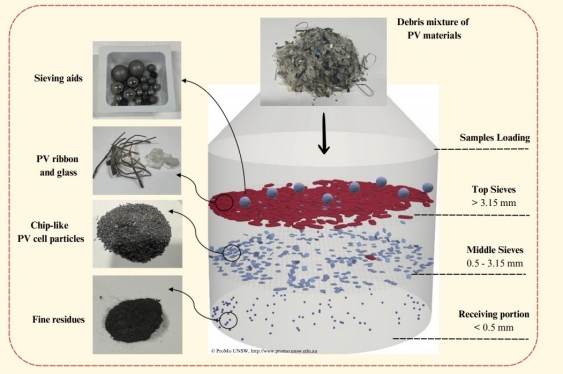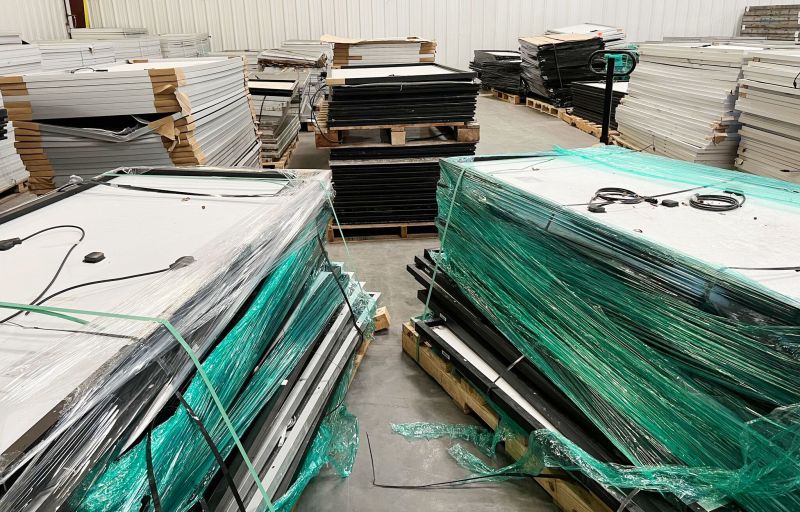The patented process includes the use of stainless steels balls as a high-abrasion sieving aid with the University of New South Wales (UNSW) team saying that in tests they have been able to extract 99% of the components, including silver, from the solar cell for potential reuse.
Recycling end-of-life solar panels thoroughly continues to prove a challenge with the individual materials, including glass, silicon, precious metals, wiring and plastic, integrated in such a way that makes them hard to separate. For the process to be viable, components need to be carefully separated to avoid contamination which has proven hard to achieve.
But now a team from the UNSW Process Modelling and Optimisation of Reacting Flow (ProMO) lab, led by Professor Yansong Shen, has announced a new process that allows them to quickly and efficiently sort the individual materials.
The process integrates conventional methods for the separation of large components, such as the aluminium frame and glass sheets, and crushing of the cell but relies on a very highly abrasive separation system to improve the process.
“The key to our new process is the addition of the sieving aids which help to crush the solar cells into smaller particles allowing a better separation of all the components,” Shen said.
“That makes it much easier to recover important elements such as the silver contained in the solar cells.”

The ProMO research team discovered that using stainless steels balls as a sieving aid provided the optimal solution for the process.
“We spent around three or four months working on that element, also testing with sieving aids made of clay or plastic,” team member Chengsun He said. “We can use different size sieving aids for different stages of the process. The main goal is to ensure that all of the PV cells particles can be crushed by the sieving aids, while the glass and other significant material remains intact at the top.”
The entire crushing and sieving process, which occurs inside a vibrating container, takes about 5-15 minutes to effectively separate 99% of the materials.
Once the material has been separated using the new patented process, the team is able to employ a traditional chemical leaching, as well as precipitation to extract the specific elements such as pure silica and silver, which accounts for about 0.05% of the total weight of a panel but makes up approximately 14% of the material value.
Shen said the team is already working with some industry partners “but we would like to engage in more industry collaborations to scale this process up and enhance the economic feasibility of the PV recycling process.”
“Our group of 30 researchers is the largest in Australia working on PV recycling technology development, not lifecycle assessment only, and probably one of the largest in the world,” he said. “This patent is just one part of one recycling process for end-of-life solar panels and we are also working on other solutions to the other steps.”
The International Renewable Energy Agency has projected that the cumulative PV waste volume on a global scale will reach up to eight million tonnes by 2030. And that figure soars to up to 78 million tonnes of waste by 2050 as successive generations of solar panels installed at the start of the century come to their end of life.
This content is protected by copyright and may not be reused. If you want to cooperate with us and would like to reuse some of our content, please contact: editors@pv-magazine.com.









24 comments
By submitting this form you agree to pv magazine using your data for the purposes of publishing your comment.
Your personal data will only be disclosed or otherwise transmitted to third parties for the purposes of spam filtering or if this is necessary for technical maintenance of the website. Any other transfer to third parties will not take place unless this is justified on the basis of applicable data protection regulations or if pv magazine is legally obliged to do so.
You may revoke this consent at any time with effect for the future, in which case your personal data will be deleted immediately. Otherwise, your data will be deleted if pv magazine has processed your request or the purpose of data storage is fulfilled.
Further information on data privacy can be found in our Data Protection Policy.